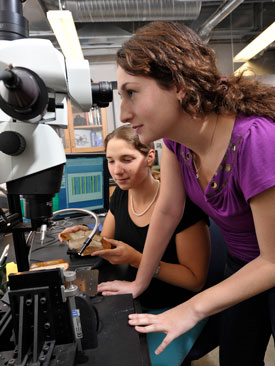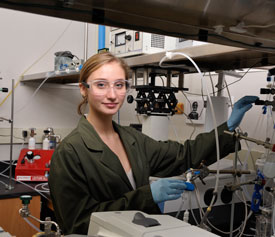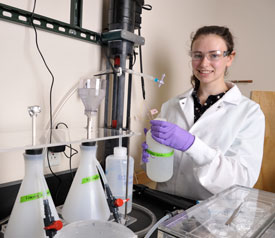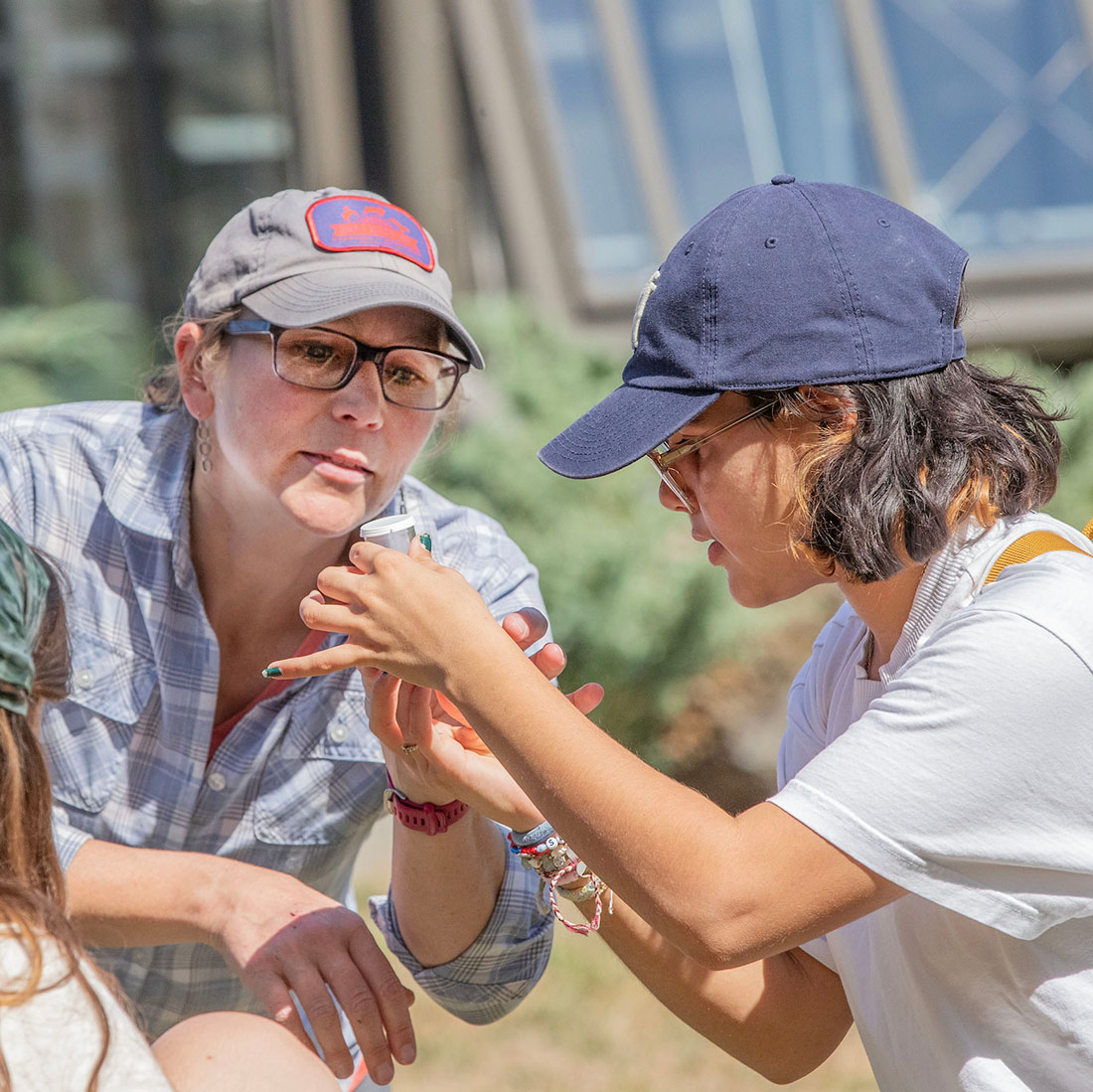Students advance climate-systems research
Big weather

Katie Kuklewicz ’15 and Sarah Turner ’15 put a
stalagmite specimen under the scope.
In Skidmore’s Stable-isotope and Paleoclimate Analysis Lab, students huddle with Amy Frappier, holder of the Lubin Chair for Women in Science, to probe an old stalagmite for insights into the role climate may have played in Maya culture. Collected during fieldwork in 2007 at the Cenote Chaltun-Ha cave in Mexico’s Yucatan Peninsula, the stalagmite is made up of thin layers of mineral deposits that had begun accumulating around 200 BCE. Researchers can read the layers much like the rings in a tree trunk.
“These stalagmites contain a lot of information,” notes Frappier, “and we interrogate them for answers about the past just as detectives might question a witness in a crime investigation.”
Geosciences and mathematics major Katherine Kuklewicz ’15 is examining the stalagmite for evidence of long-ago volcanic eruptions and other “high-magnitude weather events” such as hurricanes and droughts. The hope? “By better understanding the past, we can better predict how environments will respond in the future,” Kuklewicz says.
The 8-inch stalagmite was sliced vertically and polished before tiny samples of it were analyzed in a special mass spectrometer that can quantify the elements in its layers. The equipment’s laser blasts a thin line across the sample, releasing material including trace amounts of metals and salts. Kuklewicz’s research focuses on the last 500 years, preserved in the top couple of inches. Picking up on previous work, she’s applying an advanced statistical time-series technique to separate the effects of volcanic eruptions from other factors, such as land use of the ranch above the cave or flooding from hurricanes. Mexico’s Paricutin volcano erupted many times, producing a large amount of ash that cooled the region, fertilized the soil, and likely became incorporated in the stalagmite over time.
“My analysis should show how the area was affected by extreme events like volcanic eruptions and perhaps El Nino and solar cycles,” Kuklewicz explains. “Hopefully, this will advance our knowledge about how climate changes in the past can guide our predictions for future planning and investment in the region.”
Kuklewicz says the connectivity among the Earth’s systems excites her, and Skidmore offers “a wonderful opportunity to engage in cutting-edge research with some of the best scientists across multiple fields.” After graduation, she plans to pursue a master’s in paleoclimatology. She has applied for a Fulbright scholarship in Canada to research Arctic Sea ice and its response to global warming.
Wet and dry
Working on the same stalagmite as Kuklewicz, environmental studies and geosciences major Sarah Turner ’15 is using its intricate translucent layers to chart seasonal variations over the past 2,000-plus years.
The Yucatan has two seasons, wet and dry. Brighter-colored mineral layers in the stalagmite were formed during wet seasons, while darker layers were deposited in dry times. Rainfall promotes plant growth, and decaying leaves produce acids in the soil, and it’s those acids percolating into the limestone bedrock of the cave that now cause the stalagmite to fluoresce under ultraviolet light. Dry-season bands are dark because there were fewer plants and therefore less acid reaching the cave. Even darker layers are the “fingerprints” of hurricanes that flooded the cave and deposited mud on the stalagmite.
To count and measure fluorescing layers, Turner uses a binocular microscope to view the stalagmite in regular light and then with a special bulb to reveal glowing areas. She says, “This work is extremely high-resolution and has the potential to provide a whole new set of information on the Yucatan climate.” She can also assess the thickness of layers, to track changes in wet-season length; so far, she has counted seasonal layers back to the year 1500 CE. “We think there are some interesting patterns in the sizes of the seasonal and annual layers, and I’m excited to examine them more closely,” says Turner, who hopes to go to graduate school for geomicrobiology and geochemistry as it relates to the bioremediation of waste or toxins. She has also applied for a Fulbright to study fluorescence cycles in sediment cores from aquatic caves.
She says, “Knowing the kind of dedication it requires to do climate research, it’s really inspiring to me that people in so many different fields around the world are working to better understand how the climate system functions.”
With the resources of the SPA Lab, Frappier notes, her students often conduct graduate-level analyses. “They’re really contributing to collecting some new data sets that can transform our view of what was happening in the climate in this sensitive area,” she says.
The dust lab

Jaya Borgatta ’16 analyzes effects of sunlight on
airborne dust particles before they gather water and
fall as rain.
The facility where chemistry major Jaya Borgatta ’16 spends a lot of time is sometimes called “the dust lab.” Its research subject is fly ash, the aerosol particulate byproduct of coal-fired power plants.
Partnering with chemistry professor Juan Navea in his Laboratory of Atmospheric Physical Chemistry, she’s leading a group of students investigating airborne particles containing iron, which serve as the seeds for the formation of water droplets that fall as rain and nourish iron-hungry ocean plankton. Since living plankton absorb atmospheric carbon, they mitigate the greenhouse effect of carbon on the climate. But those same ash particles, before they fall and feed plankton, can react to sunlight in ways that produce very powerful greenhouse gases. “So atmospheric particles can have both a warming effect and a cooling effect,” Navea observes.
Since the origin of fly ash can affect how much metal is leached from it, Borgatta is studying samples from power plants in the American Midwest and Calcutta, India. To date, she says, Midwestern fly ash leaches metal faster and in larger amounts than Indian ash. To test this, she places ash in an acidic solution for about a week and then exposes it to ultraviolet light in a solar simulator and does chemical sampling every few minutes to measure how fast the metal is dissolving into solution. She uses a spectroscope to measure the amount of metals and a microscope to analyze the shapes and sizes of the particles. Because the mineral compounds can be so complex, she later confirms the spectroscopic results by comparing them with quantum chemistry simulations on a computer. The research could provide knowledge not just about aerosols and climate but about potential uses for fly ash. It has already been used in cement, and there is talk of using it as soil stabilizer.
Navea says it’s gratifying to watch students like Borgatta, who first came to work in the lab as a sophomore. As they grow as scholars, they can begin “contributing deeply to the project. It gets to the point where you can have very deep conversations about the science and gain insights from them. Rather than a professor and student interaction, it becomes a professional interaction.”
Working closely with Navea, who is also her advisor, “has been wonderful,” says Borgatta. “Just having this research experience has been really formative, especially getting to work with a professor and talk about your ideas in a constructive environment.” After graduation, she hopes to pursue graduate work in environmental or agricultural chemistry.
Carbon flux

Melanie Feen ’16 measures carbon in phyto- and
zooplankton, to help test accuracy of a remote
sensor used in the open sea. (All photos by Gary Gold.)
Chemistry major Melanie Feen ’16 works in the lab of Meg Estapa, a geosciences faculty member. An oceanographer, Estapa is interested in carbon and iron cycles and their role on marine life and the climate.
Feen and others are working “to better understand what happens when human activity adds more carbon into the ocean,” she says. They’re calibrating an instrument known as a transmissometer, which is deployed in the ocean to measure the scattering of light as an indirect way of tracking the transport of carbon from the surface into the deeper ocean by phytoplankton. As plants, phytoplankton take up carbon and release oxygen. When they’re eaten by zooplankton, the tiny animals’ fecal pellets tend to sink, carrying the ingested carbon with them. Dead plankton are another source of sinking carbon.
“This is a really important and fundamental piece of the carbon cycle but it’s not well understood because of our limitations in getting data from the ocean,” Feen explains. Direct sampling and measuring methods are laborious and expensive and require research cruises. But Estapa currently has a transmissometer at sea. To calibrate the instrument in the lab, Feen and others have been taking the optical readings that it transmits and correlating them with other studies—for example, mass spectrometry to determine the carbon content in samples from a lab supplier, from Woods Hole, Mass., and from Saratoga Lake. Under a microscope, Feen notes the types of phytoplankton and zooplankton, and does experiments to learn more about their relationships.
They hope eventually that data transmitted from the ocean via satellite can be used on a large scale to obtain high-resolution particle-flux information from different areas in the ocean.
“This is really exciting,” Feen says, “because it means that we can study the ocean without actually being there. This could potentially fill a lot of gaps in our understanding.”
Feen’s college career has focused largely on chemistry, but she took an oceanography course in her sophomore year and began working with Estapa in the summer. “I absolutely loved it, and I soon realized that I could combine my interests,” she says. “Even though I didn’t anticipate studying climate change, I’m very thankful for this amazing opportunity.” ~ By Pamela Babcock


